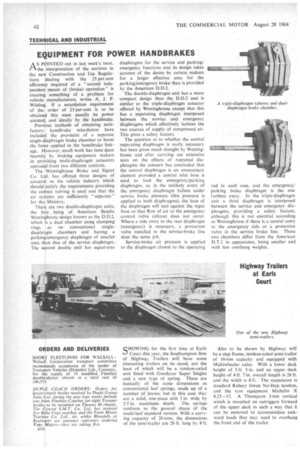UIPMENT FOR POWER HANDBRAKES
Page 44

If you've noticed an error in this article please click here to report it so we can fix it.
AS P 1NTED out in last week's issue, the interpretation of the sections in the ne Construction and Use Regula
tions • ealing with the 25 per cent efficien y required of a "second independen' means means of (brake) operation" is creatins something of a problem for vehicle manufacturers, writes A. J. P.
Wildin If a retardation requirement of the order of 25 per cent is to be obtaine this must usually be power assisted and ideally by the handbrake.
Previ us methods of obtaining satisfactory handbrake retardation have include the provision of a separate singIe-dapIiragm brake chamber to boost the for e applied to the handbrake linkage. PI wever, much work has been done recent] by braking equipment makers in pro iding multi-diaphragm actuators operate from two different controls.
The Westinghouse Brake and Signal Co. Lt s. has offered three designs of actuato to the vehicle industry which should atisfy the requirements providing the co ect valving is used and that the air sys ems are sufficiently " separate " for the Ministry.
Ther are two double-diaphragm units, the fi st being of American Bendix Westin house design known as the D.D.2, which s a dual chamber using clamping rings as on conventional singlediaphr gm chambers and having a parkin /emergency diaphragm of smaller area t an that of the service diaphragm. The s ond double unit has equal-area diaphragms for the service and parking/ emergency functions and its design takes account of the desire by certain makers for a larger effective area for the parking/emergency brake than is provided by the American D.D.2.
The double-diaphragm unit has a more compact design than the D.D.2 and is similar to the triple-diaphragm actuator offered by Westinghouse except that this has a separating diaphragm interposed between the service and emergency diaphragms which effectively isolates the two sources of supply of compressed air. This gives a safety feature.
The question as to whether the central separating diaphragm is really necessary has been given much thought by Westinghouse and after carrying out extensive tests on the effects of ruptured diaphragms the concern has concluded that the central diaphragm is an unnecessary element provided a central inlet boss is used to feed the emergency/parking diaphragm, as. in the unlikely event of the emergency diaphragm failure under service brake pressure (this pressure is applied to both diaphragms), the base of the diaphragm will seal against the input boss so that flow of air to the emergency control valve exhaust does not occur. Where a side entry to the rear diaphragm (emergency) is necessary, a protection valve installed in the service-brake line does the same job.
Service-brake air pressure is applied to the diaphragm closest to the operating
rod in each case, and the emergency/ parking brake diaphragm is the one farthest away. In the triple-diaphragm unit a third diaphragm is interposed between the service and emergency diaphragms, providing a safety feature, although this is not essential according to Westinghouse if there is a central entry to the emergency side or a protection valve in the service brake line. These two chambers differ from the American D.T.2 in appearance, being smaller and with less overhang weights.




















































































































